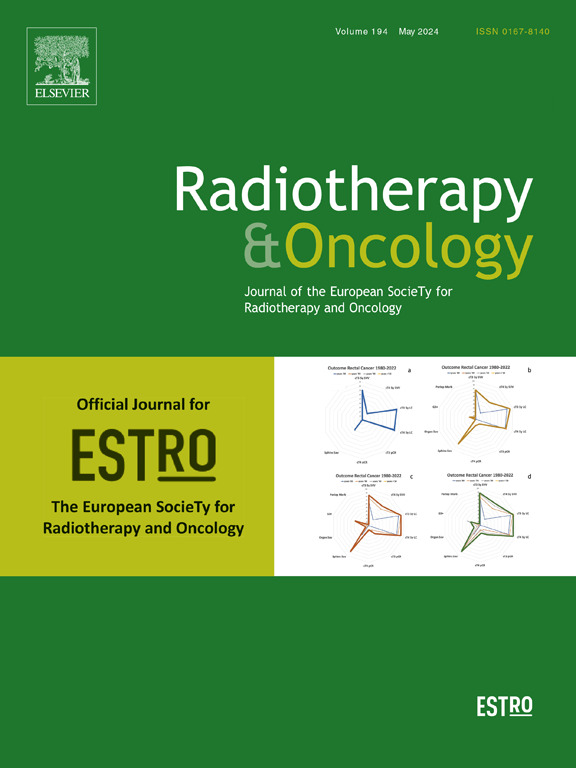Boron neutron capture therapy for cutaneous angiosarcoma and malignant melanoma: First in-human phase I clinical trial
IF 4.9
1区 医学
Q1 ONCOLOGY
引用次数: 0
Abstract
Background and purpose
Definitive radiotherapy for patients with scalp angiosarcoma has a poor prognosis, often resulting in severe skin adverse events. Additionally, malignant melanoma is known for its radioresistant nature. Boron neutron capture therapy (BNCT) may address these challenges due to the high uptake capacity of boron drugs in these cancer types. We aimed to determine the treatment dose for BNCT and evaluate the incidence of acute adverse events AEs following BNCT in patients with primary or recurrent angiosarcoma/malignant melanoma of the skin.
Materials and methods
This was a single-center, non-randomized clinical trial with a three-step dose escalation plan, involving maximum skin doses of 12, 15, and 18 Gy-Eq following a 3 + 3 design. The patients underwent BNCT between November 2019 and April 2022. The primary endpoint was to evaluate the incidence of acute adverse events.
Results
Ten patients (scalp angiosarcomanine, forefinger malignant melanoma: one) were included. The median target lesion size was 46.5 (range: 20–145) mm. A transient asymptomatic increase in serum amylase level was the only grade 3 adverse event. The best overall response rate within 180 days was 70 % (median tumor shrinkage rate: 77.5 % [4.9–100 %]).
Conclusions
BNCT with a dose of 18 Gy-Eq is a feasible treatment option, demonstrating a favorable safety profile and a high response rate in patients with primary or recurrent angiosarcoma or malignant melanoma of the skin.
硼中子俘获疗法治疗皮肤血管肉瘤和恶性黑色素瘤:首次人体 I 期临床试验。
背景和目的:头皮血管肉瘤患者的确定性放疗预后不佳,往往会导致严重的皮肤不良反应。此外,众所周知,恶性黑色素瘤具有抗放射性质。硼中子俘获疗法(BNCT)可以解决这些难题,因为硼药物在这些癌症类型中的吸收能力很强。我们的目的是确定硼中子俘获疗法的治疗剂量,并评估皮肤原发性或复发性血管肉瘤/恶性黑色素瘤患者接受硼中子俘获疗法后急性不良反应 AEs 的发生率:这是一项单中心、非随机临床试验,采用三步剂量递增计划,按照 3+3 设计,最大皮肤剂量分别为 12、15 和 18 Gy-Eq。患者在 2019 年 11 月至 2022 年 4 月期间接受了 BNCT 治疗。主要终点是评估急性不良事件的发生率:共纳入 10 名患者(头皮血管瘤、食指恶性黑色素瘤:1 名)。目标病灶的中位尺寸为 46.5 毫米(范围:20-145 毫米)。血清淀粉酶水平一过性无症状升高是唯一的 3 级不良反应。180天内的最佳总体反应率为70%(中位肿瘤缩小率:77.5% [4.9-100 %]):结论:剂量为 18 Gy-Eq 的 BNCT 是一种可行的治疗方案,对原发性或复发性血管肉瘤或皮肤恶性黑色素瘤患者具有良好的安全性和较高的反应率。
本文章由计算机程序翻译,如有差异,请以英文原文为准。
求助全文
约1分钟内获得全文
求助全文
来源期刊

Radiotherapy and Oncology
医学-核医学
CiteScore
10.30
自引率
10.50%
发文量
2445
审稿时长
45 days
期刊介绍:
Radiotherapy and Oncology publishes papers describing original research as well as review articles. It covers areas of interest relating to radiation oncology. This includes: clinical radiotherapy, combined modality treatment, translational studies, epidemiological outcomes, imaging, dosimetry, and radiation therapy planning, experimental work in radiobiology, chemobiology, hyperthermia and tumour biology, as well as data science in radiation oncology and physics aspects relevant to oncology.Papers on more general aspects of interest to the radiation oncologist including chemotherapy, surgery and immunology are also published.
 求助内容:
求助内容: 应助结果提醒方式:
应助结果提醒方式:


